You are here - Virginia Beach and Chesapeake Bay Fish Species
Virginia Beach and Chesapeake Bay Fish Species
There are many Sport Fish Species off of the Virginia and North Carolina coasts, including big billfish. When you visit Virginia Beach for your fishing vacation you will certainly have a chance at catching one or more of the species listed below. So check out the fish, book your charter, and get ready to hook up with one of these magnificent sea creatures on your next visit.
| Species | Bait or Lure | Fishing Style |
Location | Seasons | Average Weights |
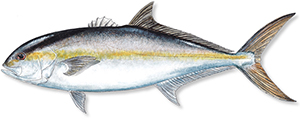 |
|||||
| Amberjack | Live bait (spot, croaker, bluefish, menhaden, small fish); Artificial lures (spoons, surface plugs, diamond jigs, white bucktails, plastic squids) | Drifting and slow trolling live bait over and around obstructions (wrecks, reefs, towers, buoys); casting and trolling artificial lures over and around obstructions | Ocean waters over and around wrecks & underwater obstructions; Chesapeake Light Tower | June - October; peak July - middle September | 30 – 60 pounds |
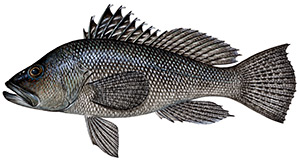 |
|||||
| Black Sea Bass | Squid, crab, cut fish, clam, shrimp, diamond jigs, metal jigs | Bottom fishing, generally near and over underwater obstructions (wrecks, reefs, rocks and rough bottom areas) | Ocean waters; species less plentiful (especially large individuals) in lower Chesapeake Bay | April - December; species moves to waters offshore (20 fathoms and more) during winter, where they can be caught over wrecks and ledges | 1 – 3-1/2 pounds |
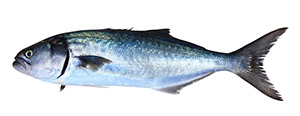 |
|||||
| Bluefish(large) | Artificial lures (spoons, tube eels, metal squids, surface plugs), cut bait (fresh menhaden, mullet, herring, spot), whole balao or Boston mackerel | Trolling, casting or jigging to schools of fish with artificial lures; surfcasting with cut bait or lures; chumming while using cut bait; bluefish can be taken on streamer flies with a fly rod | Offshore and coastal waters; Chesapeake Bay; Eastern Shore barrier island surf | Middle April - July; October - December | 8 – 16 pounds |
| Bluefish(small) | Artificial lures (small spoons, feather lures, metal squids, surface plugs) and cut bait | Trolling or casting to schools of fish with artificial lures; surfcasting and bottom fishing with cut bait; surfcasting with artificial lures | Chesapeake Bay, coastal ocean waters, ocean surf, inlets | May - October | 1 – 5 pounds |
 |
|||||
| Cobia | Live bait (eels, spot, menhaden, mullet); artificial lures (large spoons, white bucktails, plastic eels, swimming plugs); cut bait (menhaden or spot) | Cast, drift or slow troll live baits around buoys, underwater obstructions and schools of fish swimming on the surface; anchor, chum and fish live baits, fresh dead baits and cut bait in chum slick and on bottom; cast and troll lures around buoys, obstructions and to schools of bullfish (rays) or schools, pods or individual cobia swimming on surface | Buoys in lower Chesapeake Bay, at the mouth of the Bay and along coastal beaches; CBBT; Bluefish Rock off Hampton, Cabbage Patch and Kiptopeake areas off Cape Charles, and York Spit area; coastal buoys and wrecks; Chesapeake Light Tower; Latimer Shoal; Inner Middle Ground Shoal; York Spit area | May - September; peak mid-June - mid September | 20 – 50 pounds |
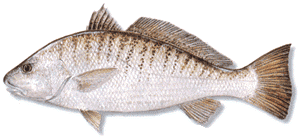 |
|||||
Croaker |
Peeler crab, bloodworms, cut bait, squid, shrimp | Bottom fishing with bait, anchored or drifting from boats, and also caught from piers, docks, shore and surf | Chesapeake Bay, tributary rivers of the Bay, coastal ocean waters, inlets | March - November | 1/2 – 2 pounds |
 |
|||||
| Black Drum | Whole clam, peeler crab, whelk, peeler crab/clam “sandwich”, bucktail and leadhead jigs | Bottom fishing with bait on “fishfinder” rig; running tides and late afternoons and evenings considered best; occasionally caught on bucktails or metal squids by casting or jigging to a school of fish | Chesapeake Bay along shallow portion of channel ledge running from Fisherman’s Island to north of Cape Charles, especially off Kiptopeake, at Cabbage Patch and buoys C-10 & C-12; around middle ground bars of Eastern Shore seaside inlets; 2nd & 3rd Islands of Chesapeake Bay Bridge Tunnel | May - September; peak May - early June along Eastern Shore bayside and seaside inlets; peak late June- early August at 2nd & 3rd Islands of Chesapeake Bay Bridge Tunnel | 40 – 60 pounds |
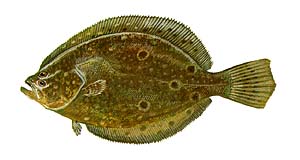 |
|||||
| Flounder | Live bait (minnows and small fish), frozen minnows, fresh strip baits (bluefish, flounder andshark belly, squid), minnow/ strip combination, artificial lures (bucktails); big strip baits and live spot or small mullet often used for big fish at Chesapeake Bay Bridge Tunnel | Drift fishing with live or dead natural baits fished on the bottom; slow trolling natural baits on bottom; casting from beaches and piers; trolling small bucktails dressed with strip baits (especially for big fish along Chesapeake Bay Bridge Tunnel); casting bucktails | Seaside inlets of the Eastern Shore; Chesapeake Bay Bridge Tunnel area; lower Chesapeake Bay; Rudee Inlet; the Cell and eastern end of the “Cut” Channel in the middle Chesapeake Bay | March - November; peak May - July on Eastern Shore seaside; July - October in Chesapeake Bay | 1 – 3 pounds |
 |
|||||
| Kingfish (Roundhead, Whiting) | Bloodworms, shrimp, small pieces of cut bait, squid, sand fleas | Bottom fishing with bait | Surf zone of coastal waters from Sandbridge to Assateague Island; ocean piers; lower portion of the Chesapeake Bay, including lower bay piers | May - October | 1/2 – 1-1/2 pounds |
| Mackerel, Atlantic (Boston Mackerel) | Small tube worms and jigs | Jigging to schools of suspended fish | Coastal and offshore ocean waters, from 5 - 35 miles offshore | Mid February – mid April peak March - early April | 1/2 – 3 pounds |
| Mackerel, King | Live bait (menhaden, mullet, spot, small bluefish); artificial lures (spoons, feather lures, nylon jigs); strip baits and small whole balao | Slow trolling, drifting or anchoring with live bait; trolling with artificial lures, strip bait and balao | Coastal and offshore ocean waters, particularly around wrecks, towers, obstructions, ledges, lumps and other “structure”; mouth of the Chesapeake Bay and off ocean inlets | June - October; peak September - middle October | 5 – 20 pounds |
| Mackerel, Spanish | Small artificial lures (spoons, metal lures, feather and nylon lures), small live baits (menhaden, mullet) | Trolling; casting to schools of fish | Coastal ocean waters, particularly off inlets, along tidelines, and over coastal wrecks; lower Chesapeake Bay | June - October; peak June - September | 1 – 3 pounds |
| Sharks | Whole dead fish and cut fish;live bait (fish) | Anchor, chum and fish dead and live fish baits in chum slick and on bottom | Offshore and coastal ocean waters, particularly around and over obstructions (wrecks, reefs, towers), ledges and lumps; Eastern Shore seaside coastal waters and inlets | June - October | 50 – 250 pounds |
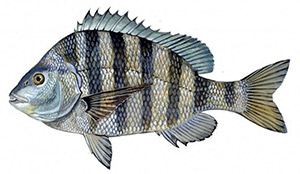 |
|||||
| Sheepshead | Fiddler crabs, mole crabs(sand fleas), clams | Fishing bait near the bottom (suspended off the bottom) near submerged structures | Chesapeake Bay Bridge Tunnel; wrecks in nearshore coastal waters and lower Chesapeake Bay | May - October | 3 – 8 pounds |
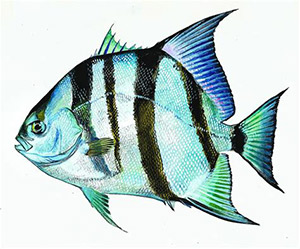 |
|||||
| Spadefish | Pieces of fresh mussels and clams; pieces of jellyfish | Fish visible schools of fish around obstructions (buoys, towers, etc.) with small (#1 or #2) double strength hooks | Coastal ocean waters and the lower Chesapeake Bay; Fish consistently found at the Cell, Plantation Light, York Spit Light, Tiger wreck, 4A-buoy, Chesapeake Light Tower, and CBBT | May - September | 3 – 8 pounds |
 |
|||||
| Spot | Bloodworms, peeler crab, clam | Bottom fishing with bait; anchored or drifting from boats, also caught from docks, piers, shore and surf; big runs of fish in the fall in lower Chesapeake Bay and in surf and piers of Virginia Beach | Chesapeake Bay and Bay tributary rivers, coastal ocean waters, inlets - all inshore coastal waters | June - October; peak July - September for Chesapeake Bay and tributary rivers; peak middle August - middle October in lower Bayand coastal ocean areas | 8 – 12 ounces |
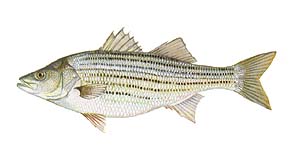 |
|||||
| Striped Bass | Artificial lures (spoons, plastic eels, bucktails, surface plugs, swimming plugs), peeler crab, bloodworms, eels, cut bait, live bait | Troll artificial lures around bridges, piers, Chesapeake Bay Bridge Tunnel, jetties or troll in vicinity of schools of fish (where gulls diving and slicks on the water); cast bucktails and plugs around bridges, piers, jetties and CBBT; bottomfishing with bloodworms in deep holes, creeks and rivers that flow into Chesapeake Bay during winter months and in Assateague surfduring late fall and early spring; peeler crab baits fished in tributary rivers and creeks near shore during summer | All coastal inshore and Chesapeake Bay waters (tidal waters, including Bay tributary rivers and Eastern Shore bayside creeks); best concentrations of fish in main portion of Chesapeake Bay and around Chesapeake Bay Bridge Tunnel; large fish most often found along CBBT, main portion of Chesapeake Bay and off the Virginia Capes at the mouth of the Bay; Assateague surf in late fall and early spring | January - December; peak for large fish in November and December; peak fishing for school fish generally in spring and fall | 5 – 25 pounds |
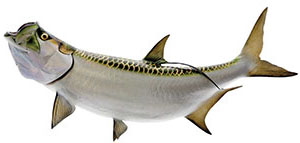 |
|||||
| Tarpon | Whole dead fish (spot, croaker, menhaden); live bait (spot, croaker, menhaden, mullet); whole squid; artificial lures (plugs and weighted streamer flies) | Anchor and fish live bait under floats, fish dead bait on the bottom and at various depths; cast artificial lures to rolling fish | Inlets, interior marsh areas, and ocean waters along the beaches of Eastern Shore seaside barrier islands; fish deep holes on low tides and shallow areas on high tides | Late June early September; peak July - August | 40 – 80 pounds |
 |
|||||
| Tautog | Crab (blue, fiddler, green and mole crabs); clams; whelk | Bottomfishing with bait over underwater obstructions (wrecks, reefs, rocks) | Wrecks and reefs in ocean waters off the coast and in lower Chesapeake Bay; along Chesapeake Bay Bridge Tunnel | January - December peak March - June and October- December | 3 – 6 pounds |
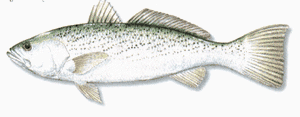 |
|||||
| Trout, Gray (Weakfish) | Artificial lures (bucktails, lead jigs with plastic tails, metal jigs), live bait (spot and small mullet), peeler crab, squid, cut bait | Jigging or casting artificial lures to schools of fish on bottom or suspended above the bottom; bottomfishing with live and natural baits from anchored or drifting boat; surfcasting with cut bait or squid | Large fish: Chesapeake Bay Bridge Tunnel, Chesapeake Bay over deepwater rocks,and along channel edges, and occasionally in Eastern Shore seaside inlets, Small fish: Coastal ocean waters and inlets of Eastern Shore seaside, Chesapeake Bay along channel edges and over deepwater rocks, Chesapeake Bay Bridge Tunnel (especially between 4th Island and High Level Bridge), Chesapeake Bay tributary rivers (especially James, York and Rappahannock) | May - November; peak at Chesapeake Bay Bridge Tunnel May June and October; peak in Chesapeake Bay, Bay tributary rivers, and Eastern Shore seaside inlets June September; peak in ocean waters off Eastern Shorefrom middle September-November | 1 – 8 pounds |
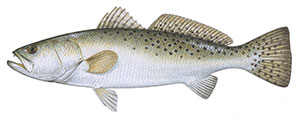 |
|||||
| Trout, Speckled | Artificial lures (mirro-sided plugs, bucktails, plastic tail jigs), peeler crab, live bait (small spot, mullet); live shrimp | Spring method: peeler crab baits fished near shore of marshy or grassy areas on flooding tides; Fall method: casting artificial lures; also some live bait fishing, trolling and jigging | Spring: Mobjack Bay area (North, Ware, East, Piankatank Rivers); submerged grass flats and marshes of northern Eastern Shore bayside, Rudee Inlet with lures. Fall: Lynnhaven Inlet, Rudee Inlet; Eastern Shore bayside creeks, Mobjack Bayarea, Windmill Point and Gwynn’s Island; Poquoson Flats | April - Middle December; peak May - middle June and September - November | 2 – 4 pounds |
 |
|||||
| Tunny, Little (False Albacore) | Artificial lures (small feather and nylon lures, spoons, cedar plugs), strip baits | Trolling, can cast small metal lures to schools of fish on surface | Offshore and coastal ocean waters; occasionally in lower Chesapeake Bay | May - November | 6 – 14 pounds |
Are you ready for
an awesome Fishing Trip?
Call (757) 613-1031 Now!
Current Virginia Beach Tides
Saturday July 27th, 2024
04:31 AM
04:31 AM
1.51 ft
-0.94 ft / hr
-0.94 ft / hr

Next: Low
Sat 7:01 AM
-0.17 ft
Sat 7:01 AM
-0.17 ft
Current Virginia Beach Weather
Uh oh, Weather XML didn't load!
Conditions:
Temp: °F
Wind:
Humidity: %
Dew Pt: °F
Visibility mi